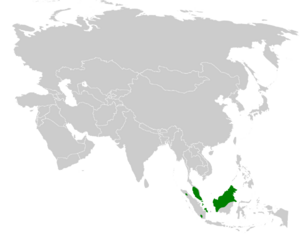Straw-headed bulbul facts for kids
Quick facts for kids Straw-headed bulbul |
|
|---|---|
 |
|
| In Singapore | |
| Conservation status | |
| Scientific classification | |
 |
|
| Synonyms | |
|
The straw-headed bulbul (Pycnonotus zeylanicus) is a special type of songbird. It belongs to the bulbul family, Pycnonotidae. You can find this bird in places like the Malay Peninsula and Borneo.
These birds live in many different natural places. They like subtropical or tropical moist lowland forests and subtropical or tropical mangrove forests. They also live in subtropical or tropical moist shrubland, arable land (farmed land), plantations, and even gardens in the countryside. Sadly, the straw-headed bulbul is in danger. Its homes are disappearing, and people are illegally hunting them.
People really value the straw-headed bulbul for its beautiful singing. Bird lovers in Southeast Asia, especially in Indonesia, want these birds a lot. This demand for pet birds is causing their numbers to drop quickly. It makes it very hard to protect them. More logging roads in their forest homes have made it easier for trappers to catch them. Because of this, the straw-headed bulbul's status changed in 2018. It went from being an endangered species to a critically endangered one on the IUCN Red List. This means it's very close to disappearing forever.
About the Straw-Headed Bulbul's Name
The straw-headed bulbul got its official name in 1789. A German scientist named Johann Friedrich Gmelin described it. He first thought it was a type of starling. He gave it the scientific name Sturnus zeylanicus.
Gmelin based his description on notes from an English bird expert, John Latham. Latham had called it the "Ceylonese stare" in 1783. Both Latham and Gmelin thought the bird came from Sri Lanka (which used to be called Ceylon). But they were mistaken! In 1924, scientists found out the bird actually came from Java.
Today, the straw-headed bulbul is part of a group of 32 species. This group is called Pycnonotus. A German zoologist named Friedrich Boie created this group in 1826. The straw-headed bulbul is a unique species. It does not have any different types or subspecies.
People sometimes call this bird by other names too. Some call it the straw-crowned bulbul. Others know it as the yellow-crowned bulbul.


